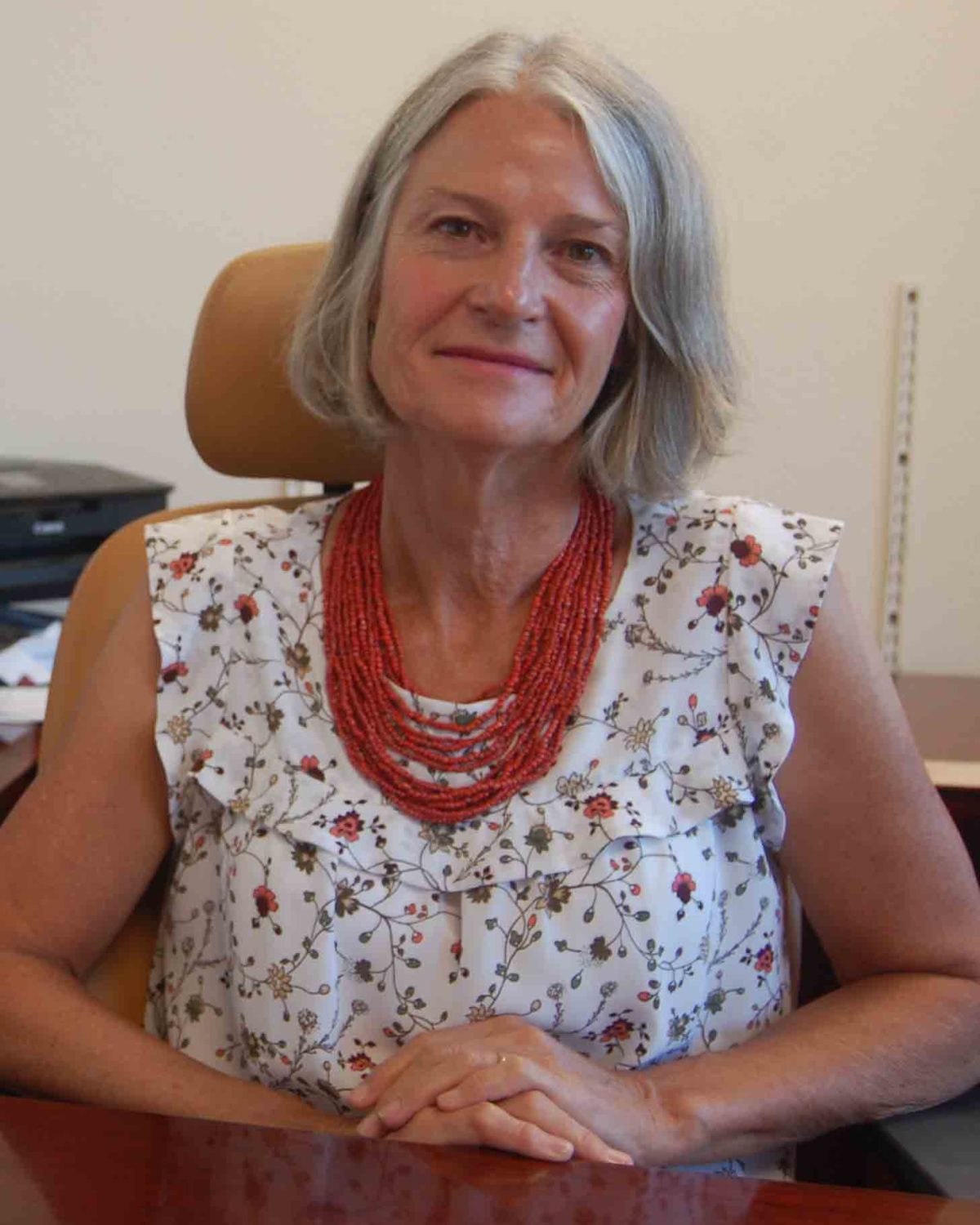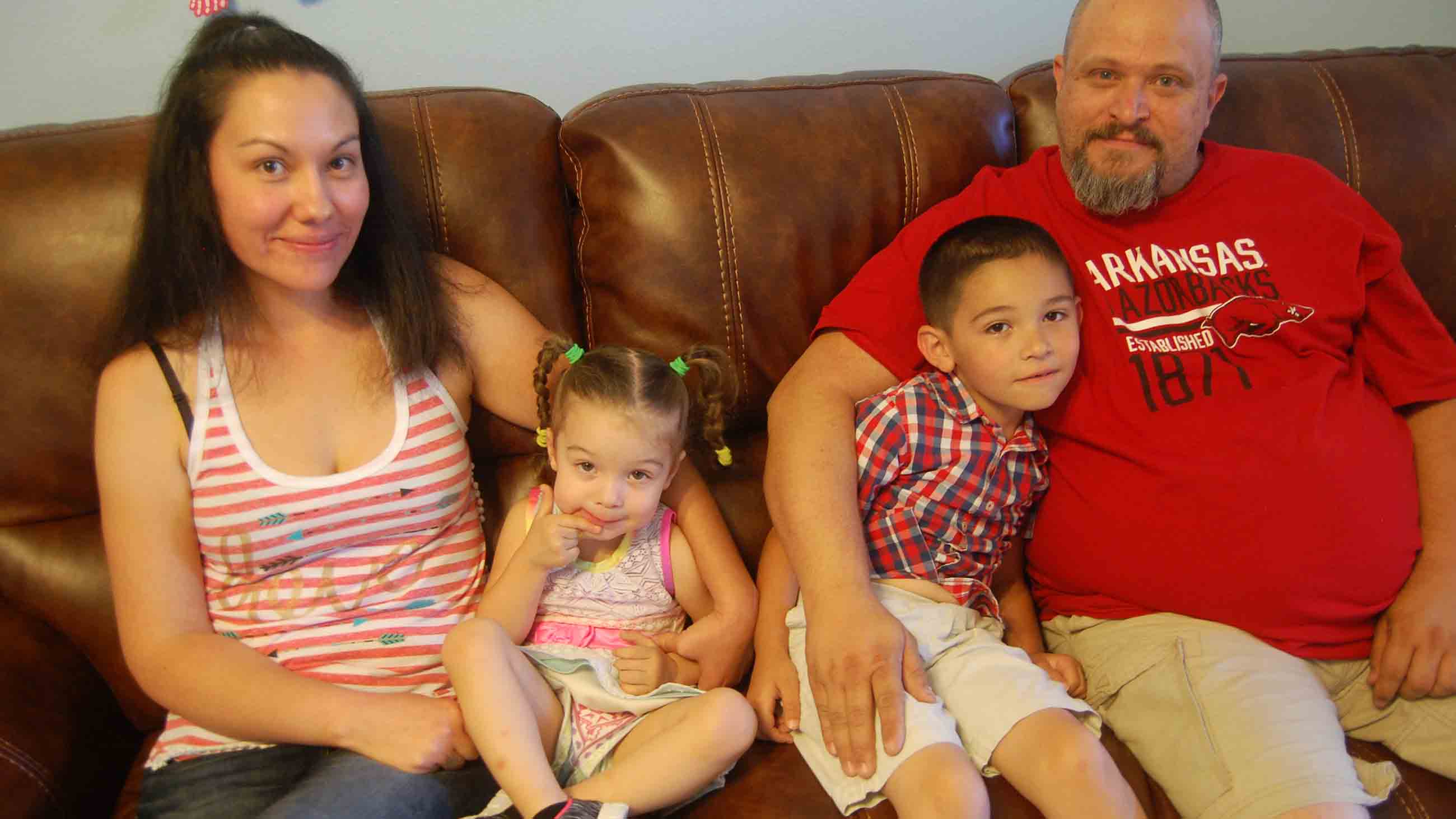For New Mexico Families, Connecting the Dots of an Ancestral Disease
On a recent Saturday morning, two-year-old Ryleigh and five-year-old Colton Arnett play with brightly colored play dough in the family room of their Albuquerque home. Colton narrates his creations with a gap-toothed smile. “I’m going to use a mold. I’m going to make a boat.” Ryleigh echoes him enthusiastically, “Mold! Boat!”
Their mother, Lori Dunworth, remarks that Colton and his sister don’t usually play so well together. “Usually she’s a bit of a bully when it comes to toys.”
Both Ryleigh and Colton receive speech therapy because of something that happened to Colton several years ago, when Dunworth and her husband, Toby Arnett, first noticed that Colton, who was two at the time, was making repeating clicking sounds while his face twitched on one side. After one episode lasted over 20 minutes, they called their doctor, who told them to take him to the hospital immediately.
Colton had suffered a seizure, and scans would later reveal masses in his brain — lesions, it turned out, caused by abnormal blood vessels. “The original impact was devastating,” Arnett says.
Colton was ultimately diagnosed with Cerebral Cavernous Malformations (CCM), a rare disease that can cause seizure, stroke, and death. He also tested positive for a genetic mutation that causes the disease, known as the Common Hispanic Mutation. Colton’s sister and his mom also have the mutation. Dunworth had no idea she was the carrier. “I’ve never had any symptoms, no seizures, no paralysis, no nothing,” she says.
Like Dunworth, many New Mexican families trace their lineage back hundreds of years to the first Spanish settlers. Yet it turns out that this shared heritage created a unique medical risk. CCM affects about one in 500 people in the general population, but in some New Mexico communities, it affects one in 50. About half the people with the mutation are asymptomatic, but everyone who has it is a carrier. And because the mutation is found on a dominant gene, parents have a 50 percent chance of passing on the disease to their children.
Everyone with the Common Hispanic Mutation shares a common ancestor, who arrived in New Mexico more than 400 years ago. After colonization, many Hispanic New Mexicans lived in small, geographically isolated communities, often intermarrying. Because of the founder effect, CCM is now found in high frequency in the descendants of those communities.
Today, an estimated 30,000 New Mexicans carry the mutation, and the numbers are increasing — even as many thousands continue to go undiagnosed. In part, this is because most New Mexico counties are considered medically underserved, and many in rural areas have limited access to health care. And while a genetic test is available, many New Mexicans — including some with misgivings about the medical system — choose not to be tested.
One advocacy group is trying to change this with a new approach to CCM outreach — one that emphasizes genealogy and shared heritage. Whether it will work remains an open question.
One morning last month, a group of elders gathered in the dining room of a Santa Fe senior center to learn about the Baca Family Historical Project, an initiative of the Angioma Alliance, a national advocacy group for people with CCM. It’s almost lunchtime, and the scent of cooked broccoli drifts out of the kitchen. Over the din of a neighboring crafts workshop, Joyce Gonzales asks whether any of the attendees are related to the Baca family, among the first Spanish settlers to arrive in New Mexico around 1600. One man speaks up.
“I’m Cabeza de Baca,” he says.
“Actually,” Gonzales replies, “I suspect every Hispanic in this room is in some way or another from the Baca family.” She’s traced descendants of the Bacas to many surnames common in New Mexico: Espinoza, Martinez, Romero, Silva.
Then Gonzales explains how CCM is a disease linked to the Baca family, a connection only recently discovered. CCM causes weak-walled vessels in the brain or spine, which can bleed slowly or hemorrhage rapidly, leading to symptoms ranging from headaches to stroke or death. Gonzales has the disease, it turns out, and it’s thanks to her work as an amateur genealogist that the mutation has recently been traced to the probable founding couple, Cristóbal Baca and his wife Ana. While most of their descendants still live in New Mexico, the mutation has spread across the American Southwest and Northern Mexico, following travel and migration patterns.
Gonzales shares her own family’s story, tragically impacted by CCM when her cousin lost his nine-year-old daughter, who had never been diagnosed. Then she makes her pitch to the elders gathered: Even if you have never had symptoms, if you are a Baca descendant you should think about getting the genetic test. Your child “may be a bleeder,” she says. “Why do we want to know? For that reason exactly, for our children, our grandchildren, our great grandchildren.”
After the talk, one of the seniors gathered, Valentin C’ de Baca, scans a vast Baca family tree for familiar names. He recognizes several: Montoya, Ortiz, Delgado. C’ de Baca says that when he was young, his dad told him about a problem that ran in the family. “He used to get migraine headaches,” he says. “They kind of go blind and get numb at one side.” He doesn’t think anyone in his family has symptoms now, but he is thinking of getting tested.
Another attendee, Josephine Garcia, already knows about CCM: Her nephew’s branch of the family has the mutation, and several of his children and grandchildren have had brain surgery. But she came to the presentation to learn more. “I had migraines since I was 10, until about 7 years ago,” she recalls, but she hasn’t been tested. “I figured at my age and what I’ve been through, I think it’s done with me.” But both of her daughters tested negative. “Ignorance is not bliss,” she says, and she plans to share the information she’s learned with others.
Gonzales says they’ve done these presentations around the state, and the response has been mostly positive — though they have encountered criticism. “We had a representative from down south get very upset about — why are we pinning it on the Bacas?” she says. Gonzales emphasizes the presentation includes the Bacas’ contributions to New Mexico culture. “We are not trying to demonize a name.”
For the medical community, identifying more people with the Common Hispanic Mutation is key to advancing understanding of the disease. But there are also ethical concerns, like the right of individuals to know, or decline to know, their own genetic risk.

Every person has to make their own decision about getting the genetic test, says Leslie Morrison, a professor of neurology and pediatrics at the University of New Mexico who has studied CCM for two decades, “because some people are only burdened by knowing.”
Leslie Morrison is a doctor and professor of neurology and pediatrics at the University of New Mexico who has studied CCM for two decades. Every person has to make their own decision about getting the genetic test, she says, “because some people are only burdened by knowing.” Morrison emphasizes the medical community must strike a balance between respecting individual choices and encouraging their participation in medical studies. If they can find people with a wide range of symptoms, they have a better chance of discovering therapies.
“We are trying to figure out what are the factors that would potentially convert someone from a severe form of the disease,” Morrison explains, “to someone who has very few problems with the disease.”
Around 300 people are enrolled in UNM’s CCM study, but Morrison says they would like to enroll more. Programs like Gonzales’s are helping to recruit more, but participation in research of any kind in New Mexico is generally low according to Angioma Alliance. Connie Lee, the president of the organization, says that one challenge is the reluctance to talk about the illness, “because there’s a lot of stigma attached to brain disease, especially one not well understood like this one.” Their new outreach seeks to build community. “Previously we were coming at it from a medical viewpoint and inducing a lot of fear.”
As it stands, New Mexico currently has the largest group of people with a genetic form of the disease anywhere in the world, so they’re of great interest to scientists nationally and internationally. The first drug trial for CCM was recently conducted with patients from New Mexico, and a new study by the University of Pennsylvania is examining the role of the gut microbiome on disease severity, with participation from CCM patients here.
Lori Dunworth, who’s now 30, says she’s one of the oldest known CCM carriers with no lesions. She has joined medical studies in the hope she can help her son Colton and other children. “If there’s something that I have that’s causing lesions not to grow,” she says, “I want to get that out there and make sure that there is a cure.”
With help from medication, Colton has now been seizure-free for almost three years. But for some people medication isn’t enough — their only remaining option is risky brain surgery. Yet with more studies, people with CCM may soon have options for new treatments. Dunworth says she doesn’t want other families to suffer like hers did, and she encourages them to become informed about CCM.
“I would say don’t be afraid to get tested, because knowledge is everything.”
Sara Van Note is an educator, writer, and radio producer currently based in New Mexico. She’s inspired by birdsong and accents, and fascinated by stories of resistance and resilience.











Comments are automatically closed one year after article publication. Archived comments are below.
My name is Maria Castillo ,, through ancestor.com my brother came to find out we are in related to the Baca family my great grandfather was Gregory Baca / my grandmother died of a brain bleed , 19 years ago , we thought it was due to comidine , I was thought to have MS because of all the legiones in my brain , I have so many sysmptoms . I have 5 kids and 3 grandkids how can I get tested ?
Try bacafamily.org
My brother (he is 63 years old) suffered a ministroke past February and had sequels with vision problems (with left eye more affected). That started with a stabbing headache and temporary vision loss. His movility was not affected, but reading about CCA it reminded me that the signos and symtoms are similar.
I was born in Northern New Mexico. I am not a direct descendant of the BACAs, that I am aware of. I am descendant of the Raels and Herreras. To my knowledge, the Raels have been in New Mexico for over 400 years.
I suffer from excruciating headaches, including migraines. I would be interested to find out if I have the gene mutation.
Can this be detected by CT or just MRI?
How to join a study and support group?
Hi I’m Karen, my nephew from New Mexico txt me to go to the link to read this article. Well when I was a child I used to get very bad migraines to where my mom would take me to the hospital. Well in 2011 I suffered s headache that lasted 8 days so I went to the hospital and they said I had suffered 3 strokes and they see hemmrige on my brain. I have vision loss in my eye slight paralysis r.hand and ard I just suffered another stroke again on March 7th 2019 o soul like to do this test for the sake of my kids and grandkids show Much does it cost. If you can send me info of where I can get this done
Thank you please leave a voice mail at 720-468-9330 Karen CdeBaca Martinez 4/10/19
My husband has this condition but her family is from new England and England. Dad born in Arizona. We live in el Paso Texas, next to new Mexico. How can we join the support group and the studied
Hi Rosio – we have a website at http://www.bacafamily.org that has a contact form you can complete. Or, you can write Joyce Gonzales, our genealogist, at joyce at angioma.org. She would be happy to hear from you.
The mutation described is known scientifically as rs267607203, and specifically the (T) allele (i.e. variant) at that position in the genome. It is listed in SNPedia, so it can be reported in Promethease reports (which are based on SNPedia) if there is data for it in the raw DNA data file for an individual. If a person wishes to check their status for this variant using a direct-to-consumer DNA test, they should first check if the DNA testing company says that results will be produced for rs267607203.
Hi Greg Lennon,
I have run my DNA through promethease. How would I verify if I am a carrier? I am a direct descendant of the couple. TIA
I might be able to help. The condition has similarities to Intracranial Hypertension (IIH), – headaches, vision problems –
Randal Orton, Ph.D., D.Env.
I live in northern New Mexico. I has been diagnosed with MS. I also get headaches, especially on my left side to where my hearing and vision are affected as well as cognitve abilities. I haven’t been diagnosed with seizures but on occasions, such as being overtired, stressed and/or emotionally overloaded, I shake from head to toe. Sometimes for hours, sometimes for days. Could this be associated to the Common Hispanic Mutation genome?